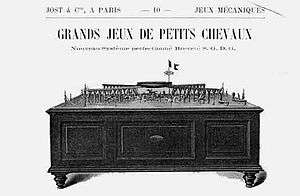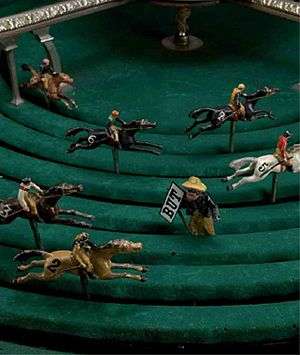Boule (gambling game)
Boule (French for ball) is the name of a gambling game, similar to roulette, that goes back to the popular 19th-century game of Petits Chevaux ("Little Horses").



Playing
The wheel is divided into 18 pockets which are numbered from 1 to 9, each number occurring twice. The numbers 1, 3, 6 and 8 are black, the numbers 2, 4, 7 and 9 are red; the 5 is yellow.
Instead of the ivory ball used in roulette, a rubber ball is thrown in Boule.
Betting options
Even odds
- Rouge (red: 2, 4, 7, 9) - Noir (black: 1, 3, 6, 8)
- Pair (even: 2, 4, 6, 8) - Impair (odd: 1, 3, 7, 9, except the 5)
- Manque (low: 1, 2, 3, 4) - Passe (high: 6, 7, 8, 9)
The number five corresponds to the zéro in roulette: if the boule falls on the five, all simple chance bets are lost.
Better than even odds
- Plein: a bet on a single number is paid at 7:1.
- Cheval: a bet on two numbers is paid at 3:1.
House advantage
The overall house advantage for all forms of betting in Boule is 1/9 = 11,1 %. Boule is thus very disadvantageous for the punter. In roulette the house advantage for simple chance is 1.35 %, and for multiple chance 2.70 %.
Boule is played for low stakes compared to roulette, especially in resorts where there is no concession for the Grand Jeu, i.e. a casino.
Petits Chevaux
In Petits Chevaux, also called Jeu des Petits Chevaux or Rösslispiel, there are the same betting options as in Boule. The winning number is not chosen, however, by throwing a ball, but by a mechanical device that simulates a horse race en miniature.
Petits Chevaux was the predecessor of Boule. The pockets of many Boule wheels are decorated with pictures of horses in commemoration of Petits Chevaux. Around 1900 Petits Chevaux was a very popular casino game. A surviving gaming table by the firm of J. A. Jost (Paris c. 1905) is displayed in the Swiss Museum of Games in La Tour-de-Peilz. Until 2003, a similar game, the horse roulette game of Klondyke, was played in Baden-Baden's casino at the time of the Iffezheim Races. The gaming apparatus is housed today in Baden-Baden's Municipal Museum.
In France the name "Petits Chevaux" is also used for a variant of Pachisi or Mensch, ärgere dich nicht; the playing stones are in the shape of knights; see Jeu des petits chevaux.
See also
Literature
- Ralph Tegtmeier: Casino. Die Welt der Spielbanken, Spielbanken der Welt. DuMont, Cologne, 1989, ISBN 3-7701-2225-9 (Bildband)
- The Complete Hoyle’s Games. Revised & updated by Lawrence H. Dawson, London 1950, Wordsworth Reference, reprint 1994, ISBN 1-85326-316-8
- Thierry Depaulis: Die "Kleinen Pferde". Ein Casinospiel der Belle Epoque, in: U. Schädler (Hrsg.): Spiele der Menschheit. 5000 Jahre Kulturgeschichte der Gesellschaftsspiele, WBG, Darmstadt, 2007, ISBN 978-3-534-21020-6, pp. 173–179